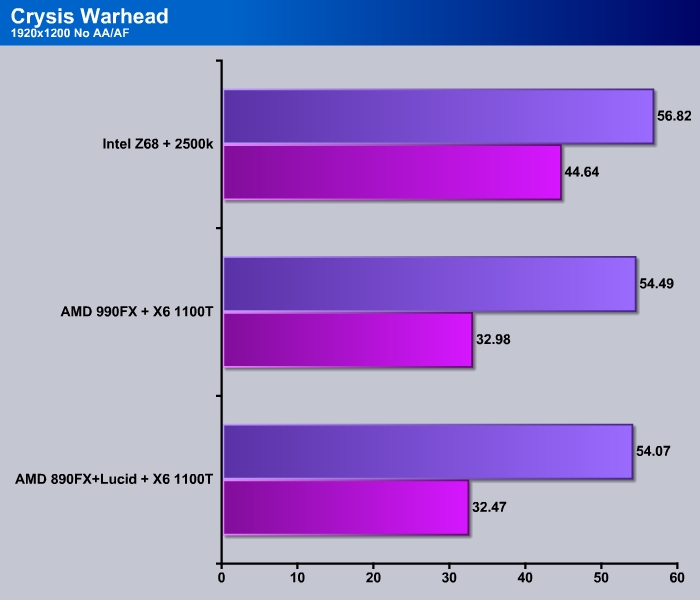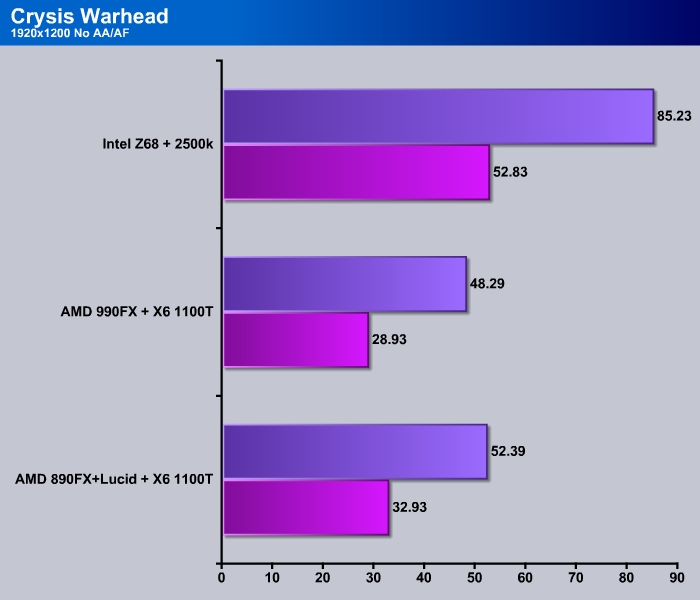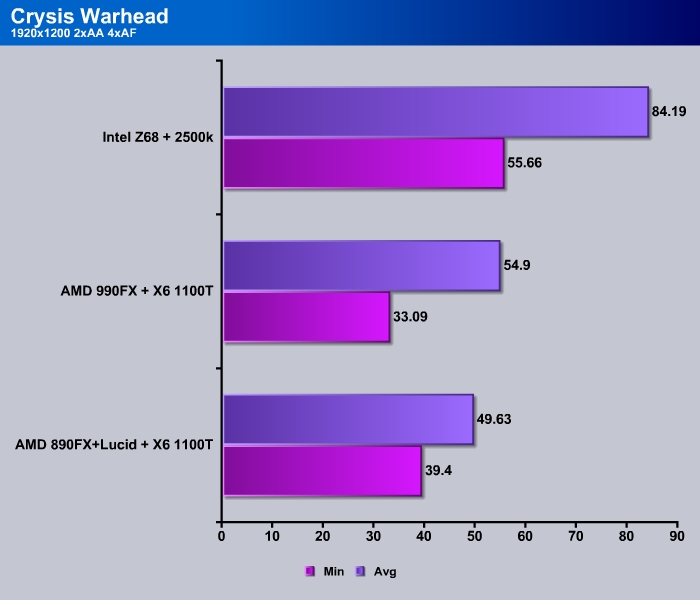AMD’s new 990FX chipset natively supports SLI, so we decided to test its impact in games. Keep reading for more.
INTRODUCTION
Note: Please read our review of the GIGABYTE GA-990FX-UD7 first. It examines the AMD 990FX chipset, and provides the context for this article.
The last time AMD folks were able to run SLI natively was back in 2009 when NVIDIA made the 980a chipset for AMD platforms. Since then, NVIDIA has left the chipset business (or rather, been forced out since AMD bought ATI). Now, AMD platform only natively support multiple AMD/ATI GPUs. Users wish to run two NVIDIA graphics cards are forced to rely on third party chips like the Lucid Hydra.
In a perfect world, users should not have to be forced to lock into a single platform. This is where Intel systems have an advantage, as many of current Intel chipsets, such as the X58, P67, Z68, and P55 chipsets support both SLI and CrossFireX. So for last few years, Intel users have had the option of using either SLI or CrossFireX. With the right chipset and motherboard, the system will be able to support both technologies.
The average motherboard and CPU lifespan in a system is often 3 to 5 years, so they usually go through a couple of GPU upgrades before they are replaced. With a GPU lifecycle of 12-18 months, a top-of-the-line GPU today can become mid-range in a year. Being locked to one platform reduces users’ options.
Up until now, for AMD users, Lucid Hydra was the only solution for SLI (besides using older GeForce chipsets for AMD). When we reviewed the ASUS Crosshair IV Extreme, we really could not assess whether Lucid Hydra has any effect on the SLI performance. While Lucid Hydra is a good solution, the biggest problem with it is that there are not many boards out there that have this chip. In addition, Hydra runs off profiles so it requires Lucid to keep the supported game lists up to date and supported the driver support up to date. If they are not up to date, users may get worse performance with two cards.
Having native support is always better, and with the release of latest 990FX chipset from AMD, the company has brought back SLI support to AMD platforms. Now, AMD users once again have the luxury of choosing from SLI or CrossFireX.
We have looked at the 990FX chipset and its performance is virtually identical to the 890FX. This is a perfect opportunity to assess the SLI performance on AMD platform using Lucid Hydra and natively supported technology. In addition, this also gives us an opportunity to examine the GPU affect on NVIDIA SLI to assess whether the current processors has any affect on the multi-GPU configuration.
We grabbed two GTX 470s and ran a slew of tests across an Intel Sandy Bridge system, AMD system with ASUS Crosshair IV Extreme board that features Lucid Hydra for SLI, and the latest 990FX chipset from GIGABYTE that offers native SLI support.
Results
3DMark Vantage
GTX 470
Let’s start with 3DMark Vantage result. The de facto graphic cards performance benchmark tool. 3DMark Vantage supports DirectX 10 features.
We show the GPU score for the 3DMark Vantage. Here we can see the latest 990FX scored about 1% faster and the latest Sandy Bridge is 5% faster than the 890FX chipset. While 3DMark Vantage is a synthetic benchmark, the result we observed is something that we will see as we go through other benchmarks where the performance between the 890FX and 990FX is close, with the 990FX often coming in a few percentages ahead of the 890FX. However, the Sandy Bridge system often yields noticeable performance gain compared to either AMD system.
2x GTX 470 (SLI)
With the 990FX natively supporting SLI, we can finally see just how much of a performance hit would come using Lucid Hydra chip for SLI. If we use 3DMark Vantage as the standard to assess Lucid perfomance, we can see that there is no performance hit with Lucid. In fact, the 890FX with Lucid Hydra actually scored a few points higher than the 990FX.
What troubles us a bit is that comparing the performance of the 990FX and the Sandy Bridge, we can see that clearly in SLI, the Sandy Bridge is the much better platform, yielding 20% better performance than the 990FX.
It is possible that NVIDIA drivers still need fine-tuning in order to fully support the 990FX but even if we take the lack of driver optimization into consideration, the Intel system is still much better than the AMD system.
Keep in mind that the AMD system is actually running at dual x16 configuration while our Intel Z68 chipset is running in dual x8 configuration. Thus, the bandwidth limitation is not an issue.
3DMark11
GTX 470
The latest 3DMark11 is a more rigorous test than the 3DMark Vantage. The benchmark supports DirectX 11, PhysX and Tessellation. The result is quite interesting. Here we can see that under Performance preset, the 990FX once again is 3% faster than the 890FX but neither platform is able to compete against Intel Sandy Bridge. However, the performance differences between three systems have narrowed under Extreme preset. Under Extreme preset, the 990FX is 2.4% and the Z68 is 7.5% faster than the 890FX. The performance difference between the AMD 990FX and the Sandy Bridge is only 5%.
Under Extreme preset, the system is most likely being bottlenecked by the GPU, and Sandy Bridge’s superior CPU power does not show its advantage.
2x GTX 470 (SLI)
A similar result is observed with two GTX 470s in SLI.
Crysis Warhead
GTX 470, no AA
2x GTX 470 (SLI), no AA
While Crysis Warhead is a bit old, it is still a good tool. We can see that the AMD system performs identical with or without SLI but the Intel system is clearly superior, almost doubling the minimum frame rates.
GTX 470. 2xAA and 4xAF
2x GTX 470 (SLI), 2xAA and 4xAF
A rather interesting result is seen here at 1920×1200 with 2xAA and AF enabled. It seems like as a single card, the performance difference between our systems is very close, with the Intel system taking an 8% lead. However, with SLI, we see the AMD systems actually give us lower minimum frame rates despite having slightly higher average frame rates.
Alien vs Predator 2
GTX 470
2x GTX 470 (SLI)
Nothing particularly unusual here, where the cards scaled quite well with SLI. The 890FX with Lucid performed well here, and was only a few percentages slower than the 990FX.
GTX 470
2x GTX 470 (SLI)
A bit surprise here with Dirt 2 where we see the AMD system actually performs worse with SLI. While the Intel system showed good gain by adding the second card, the AMD system did not. In fact, the 990FX actually performed worse than the 890FX with Lucid. It is clear that the processor is the bottleneck, as the card is definitely able to perform much better here.
Results Cont’d.
Stone Giant
GTX 470
GTX470 (SLI)
Stone Giant also shows impressive gain with the addition of second card. Here is another instance where the 990FX actually yields lower score in SLI than the 890FX.
Lost Planet 2
GTX 470
GTX470 (SLI)
GTX 470
GTX470 (SLI)
Here we see an interesting result with Lost Planet 2 where 890FX performs worse with SLI. The 990FX shows a good gain here despite scoring lower than the 890FX. This test shows that native SLI support for the 990FX is definitely appreciated.
Unigine Heaven 2
GTX 470, Normal Tessellation
GTX470 (SLI), Normal Tessellation
With Normal Tessellation and a single GTX 470, the Intel system offers about 20% gain over the AMD system in the minimum frame, but only 5% in the average frame rate. When we pair up two cards, we can see the 890FX with Lucid is unable to keep up with the 990FX chipset’s native SLI support in the minimum frame rate.
GTX 470, Extreme Tessellation
GTX470 (SLI), Extreme Tessellation
Similar to the Normal Tessellation, the result from the Extreme Tessellation also shows 890FX with Lucid falls behind the 990FX.
S.T.A.L.K.E.R: Call of Pripyat
GTX 470
GTX470 (SLI)
S.T.A.L.K.E.R.: CoP shows that with a single card, the AMD and Intel systems perform fairly similarly. The Intel system continues to dominate. When the GPU is not being pushed (Day, Night, and Rain), the Intel system is about 20% faster than the 990FX; the difference is significantly narrowed to to a few percentages with the Sun Shafts benchmark. The 990FX is about 2-28% faster here than the 890FX depending on the benchmark.
With SLI enabled, the performance difference between the Intel and AMD widens. For light GPU tests, the Intel system is 30-45% faster than the 990FX. For Sun Shaft tests, the Intel system is able to command 20% better performance than the 990FX.
For games that require high GPU performance, AMD 990FX is able to offer 10-60% better performance than the 890FX with Lucid. 890FX chipset users would clearly benefit by upgrading to the 990FX for native SLI support. However, the most troubling aspect of the AMD systems is that the CPU is the bottlenecking factor.
Conclusion
It is clear that AMD really needs a major CPU architecture overhaul as the current processors with roots stemming back to the K8 era are really getting old. Intel has released two major architectures, Nehalem and Sandy Bridge, since the Core 2 Duo era, but AMD has stuck with the same since 2003. Over the years, AMD is able to stay competitive against Intel with lower pricing and more cores, but its aging architecture has started to drag the performance down.
Most games currently do not take advantage of more than two cores,so having a quad or six-core processor is really not as important as a processor that is more efficient at data processing and is capable of higher instruction per clock ratio. As our tests show, in many of today’s games, especially those that take advantage of latest DirectX 11 features such as PhysX and Tessellation, the Phenom processors is holding the system back. The greater instruction per clock efficiency on the Sandy Bridge processor allows the system to output as much as 20%.
For a single GPU, the performance difference between AMD and Intel platforms is not as big, especially at high visual settings since GPU is often our limiting factor. However, for multi-GPU, the CPU can be the bottleneck. We do expect games going to be even more complex in the future, and most of them will support PhysX and Tessellation. As GPU technology advances, CPUs must keep pace, or else systems will suffer lags in performance.
Luckily, we do not have to wait much longer as the next generation of AMD processor, the Bulldozer, is just around the corner and will be released soon.
 Bjorn3D.com Bjorn3d.com – Satisfying Your Daily Tech Cravings Since 1996
Bjorn3D.com Bjorn3d.com – Satisfying Your Daily Tech Cravings Since 1996
































